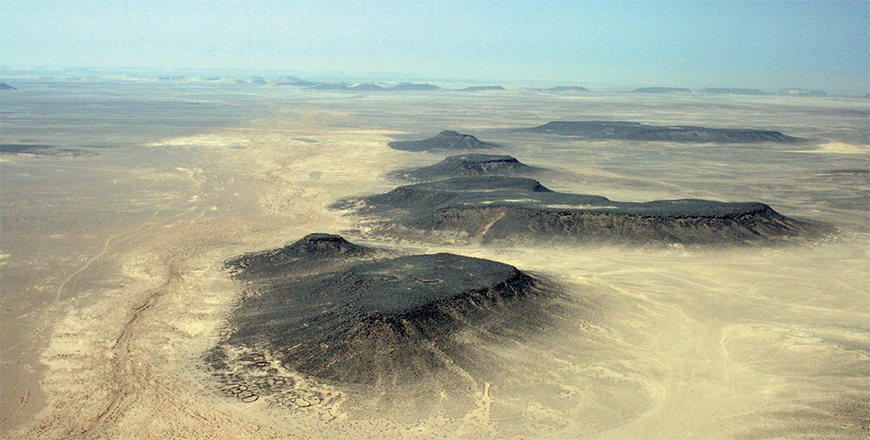You are here
Symbolism, societal roles: Analising Shubayqa’s prehistoric bone artifacts
By Saeb Rawashdeh - May 27,2024 - Last updated at May 27,2024

Final Natufian/early PPNA building at Shubayqa 6 (Photo courtesy of University of Copenhagen)
AMMAN — Shubayqa, a site located some 130 kilometres northeast of Amman, represents a hunter-gatherer spot and as such it draws attention of scholarly teams. Animal bones were used by prehistoric occupants of the site to form figurative representations, and it happened during a transitional period between Late Natufian and Pre-Pottery Neolithic. The bone assemblage consisted of 21 limbs of wild sheep and gazelle, found as artefacts and there are many theories about the interpretation of the assemblage.
According to the scholar Gary Rollefson, in the prehistoric Levant representations of the human form increase in prevalence in the archaeological record from the Natufian to the Pre-Pottery Neolithic B (PPNB). There are comparatively few examples known from the Late Epipalaeolithic (Natufian) and the Pre-Pottery Neolithic A (PPNA).
“Late Epipalaeolithic examples include a human head carved from calcite from El-Wad, a calcite head and limestone torso from ‘Ain Mallaha and the depiction of a human face on a limestone pebble from Ein Gev II,” noted Lisa Yeomans, a zooarchaeologist from the University of Copenhagen, adding that the number of anthropomorphic representations recovered from PPNA sites is more numerous.
Examples of bone as a medium for depicting the human form are even less common in these early periods, but become more frequent from the PPNB onwards.
“The interpretation of symbolism, societal role or function of anthropomorphic representations in prehistoric societies is a complex problem and labels such as ‘figurine’ and ‘idol’ can be loaded terms. The interpretation of figurines as ritual or cosmological items has been called into question, with researchers such as Fassoulas suggesting that some figures may simply be dolls,” Yeomans interpreted.
Going back to Shubayqa, the archaeological team identified an occupation spanning from 12,100 to 10,600 before present time and the site had oval structures.
This surface, a hearth and a small pit dug into the floor containing part of a human skull, represent the end of the primary occupation of this structure.
“The cluster of artefacts, left against the western wall, may have been placed within in a container of perishable material when the structure was abandoned given that the finds were all found in close association,” Yeomans said, adding that the group of artifacts includes five grooved stones, a large quantity of ostrich eggshell and worked bone items.
In addition to the finds detailed above, 116 phalanges (bones of forelimbs and hindlimbs) of gazelle and sheep were also present. Initially these bones were thought to represent a store of raw material, with a few of the first phalanges having a hole drilled into the proximal articulation, the archaeologist said, adding that once all the phalanges were cleaned, it was apparent that most of the first and some of the second phalanges had been worked to a greater or lesser extent.
“The bones formed 21 sets of articulating phalanges from a minimum of four gazelle and six sheep. Gazelle bone fusion data indicate that at least two gazelle, represented by five limbs, must have been older than approximately seven months at death. Another gazelle, estimated to have been 3–7 months old at death, was represented by one set of bones,” Yeomans underlined, adding that the last gazelle, also represented by one set of phalanges, probably died before reaching three months of age.
“Analysis of the entire faunal assemblage from Shubayqa 6 is ongoing, but thus far gazelle are more than six times more frequent than sheep,” she said.
“Although sheep were less frequently hunted than gazelle at Shubayqa 6, they are over-represented in this cluster. It is possible that sheep bones were preferred due to their larger size when compared to gazelle,” Yeomans concluded.
Related Articles
AMMAN — The eastern Black Desert is an area between modern Syria, Jordan and Saudi Arabia with plenty of evidence for the hunting activities
AMMAN — By the end of the last Ice Age, hunter-gatherers in southwest Asia who belonged to the Natufian culture (12,500 to 9,500BC), establi
AMMAN — Located some 500 metres from the old Amman-Jerash road, Tell Abu Suwwan represents one of the Neolithic mega sites whose occupation













